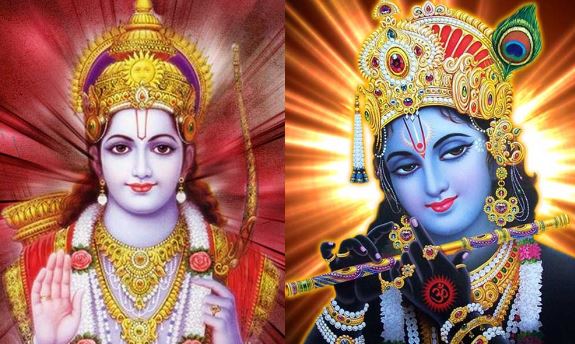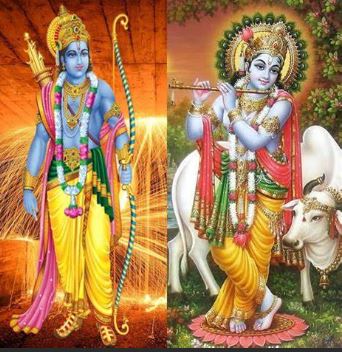“A true hero isn’t measured by the size of his strength, but by the size of his heart” LORD SRI RAMA AND LORD SRI KRISHNA, OUR NATIONAL HEROES
Yashoda and Krishna Dharma:-
Following dharma is an important attribute, specially in heroes and role models, since it is an essential characteristic for human society to survive. LORD SRI RAMA AND LORD SRI KRISHNA, OUR NATIONAL HEROES
Rama, throughout his life, was faced with many difficult situations, as if to test how he would react to the situation. He reacted with utmost righteousness in each case, so much so, they set the standards of ethical behavior. Be it when he leaves Ayodhya for the forest, when Bharata entreats him to return to Ayodhya or when he realizes that the citizens of Ayodhya are unhappy with Sita’s chastity. His stand in every situation is a shining example of what a person must do to follow dharma, irrespective of the cost to oneself.
Rama established dharma by living it in the face of travails. Rama’s approach was to live by dharma and sort out the adharma when encountered with a problem. When the sage Vishvamitra asked for his help, he accompanied him to the forests where he slayed Khara, Dhushana, and other rakshasas who were troubling the sages and their rituals. When Ravana kidnapped his Sita, he went after and killed him. The opportunities for establishment of dharma, thus presented themselves to Rama in the form of problems. LORD SRI RAMA AND LORD SRI KRISHNA, OUR NATIONAL HEROES.
Krishna’s life was probably not as personally testing as was Rama’s, in terms of the situations he had to face. Though he was born in captivity, his childhood and youth was spent in fun and frolic. His later life was filled with task after task of establishing dharma. All of the important events of his life such as the killing of Kamsa, Shishupala, Jarasandha, and the Kauravas, were done either directly by him or were motivated and mentored by him for the purpose of establishing dharma. His advice to Arjuna, the Bhagavad-Gita, is verily a treatise on dharma. In his own life he never compromised on righteous behavior. The right things to be done were never postponed nor ignored.
Krishna established dharma by destroying adharma. He was more pro-active in going after adharma. For instance, Krishna and his brother Balarama, both had the exact same upbringing and environment. Krishna, in comparison to Balarama, accomplished a lot by action oriented intervention into problem areas. This can be found in several cases mentioned above as also in his active intervention in the Kurukshetra war. LORD SRI RAMA AND LORD SRI KRISHNA, OUR NATIONAL HEROES
Hence, though Rama and Krishna both had dharma as their core value, they differed in their approach. While Rama established dharma by setting a model for generations to come, by living his life by dharma, Krishna sought out adharma, destroyed it and established dharma. LORD SRI RAMA AND LORD SRI KRISHNA, OUR NATIONAL HEROES
Strategy :-
This is an important attribute for comparison, since here again there is a marked difference, especially in perception, between our two heroes.
Rama is not specially known for his strategic or tactical thinking or decisions. At every critical juncture, he chooses the decision based on dharma. However, most of his decisions – to align with Hanuman, Sugriva and his monkey warriors, Vibhishana, all do seem strategic. He seemingly commits some tactical errors such as letting go of Ravana first time in war when he is in a position to kill him. However, it is difficult to say that these were errors since eventually he does manage to kill him. His decision of renunciation of Sita is widely believed to be a lack of
strategic or tactical thinking, but this thinking is incorrect since he had no other options and no amount of strategizing would have resolved the problem.
Krishna is believed to be a master strategist and tactician. This is because of the various events in his life such as the stage managed kidnapping of his sister Subhadra by his friend Arjuna, the slaying of Jarasandha, numerous events during the Kurukshetra war – killing of Jayadratha; his advice to Ghatotkacha when he is getting killed (to grow and fall on the enemy soldiers); his plan to field Shikhandi against Bhishma, his bringing about the end of Drona by inspiring Yudhishtira to tell a white lie; the killing of Karna when he is weaponless and has lost the memory to invoke powerful weapons; his advice to Bhima resulting in the eventual death of Duryodhana; all these are the high points of his strategic and tactical thinking.
These various events give an incomplete model of Krishna to a casual observer as cunning and manipulative person who would do anything to gain victory. It is not so. All those who are killed by strategy were invincible in one way or the other and had some weakness that had to be exploited to ensure that the ends of justice are met. In all these cases, strategy was inevitable. Moreover, Rama’s slaying of Vali was similar to many of Krishna’s tactics.
In light of these many incidents, there are many who believe that Krishna would have found some way to work, if he were in the position of Rama while abandoning Sita. They say that he would manage the subjects somehow and ensure that there were a better ending to the story. But on a little analysis, we can figure that it would not be the case. Both Rama and Krishna stand firm for dharma. The situation that was a dharma sankata (an ethical dilemma) for Rama would have been the same if it was Krishna in his place. This is shown by the incident in Krishna’s own life – the case of the Shyamantaka jewel that belonged to his friend Satrajit. Satrajit’s brother wears it while going for a hunt and loses it when he is killed by a lion. The lion takes the gem which is further won by Jambavanta, the bear. Krishna goes to great lengths, going in search of the jewel and fights with Jambavanta for 21 days to get back the jewel. Here again Krishna bows to the perception of citizens that he may have had a hand in the jewel being lost. This one incident suggests that Krishna, in Rama’s position, would have acted in the same way.
Conclusion:-
The comparison between Rama and Krishna is unfair to both since their situations, characters and times were all different. The Ramayana and Mahabharata are vastly different. Hence the comparison may seem dubious. However, since such comparative statements keep coming up amongst interested people, such an analytical exercise becomes inevitable.
While Rama is more on a human level, Krishna is in the divine plane. While Rama appeals at a personal level, Krishna appeals at a higher, structural plane. The way of life for an ideal Hindu family is modeled after Rama’s life and not as Krishna’s. This is because ordinary mortals can reasonably aim to live their lives as Rama lived his (discounting the feats of strength and valor). Krishna’s way of life is to view with awe and not something that can be followed and achieved.Since the Mahabharata has a much wider canvas and colors as compared to Ramayana, Krishna’s character at times is perceived wrongly as someone who doesn’t care about the means as long as the end is justified (as compared to Rama who is perceived as caring about the means as much as the ends). This perception, is highly unfair to Krishna. Both Rama and Krishna are equal followers and upholders of dharma. Though perceived as opposite poles in characteristics, their core values are the same.
Both Rama and Krishna are similar in most human characteristics as well as their adherence to the four purusharthas of dharma, artha, kama, and moksha, specially since artha and kama are to be pursued within the framework of dharma. While we read Krishna’s sayings in the Bhagavad-Gita about detachment and equanimity in the evening of our lives, we faithfully live our lives imitating Rama.
LORD SRI RAMA AND LORD SRI KRISHNA, OUR NATIONAL HEROESLORD SRI RAMA AND LORD SRI KRISHNA, OUR NATIONAL HEROESLORD SRI RAMA AND LORD SRI KRISHNA, OUR NATIONAL HEROESLORD SRI RAMA AND LORD SRI KRISHNA, OUR NATIONAL HEROES.

